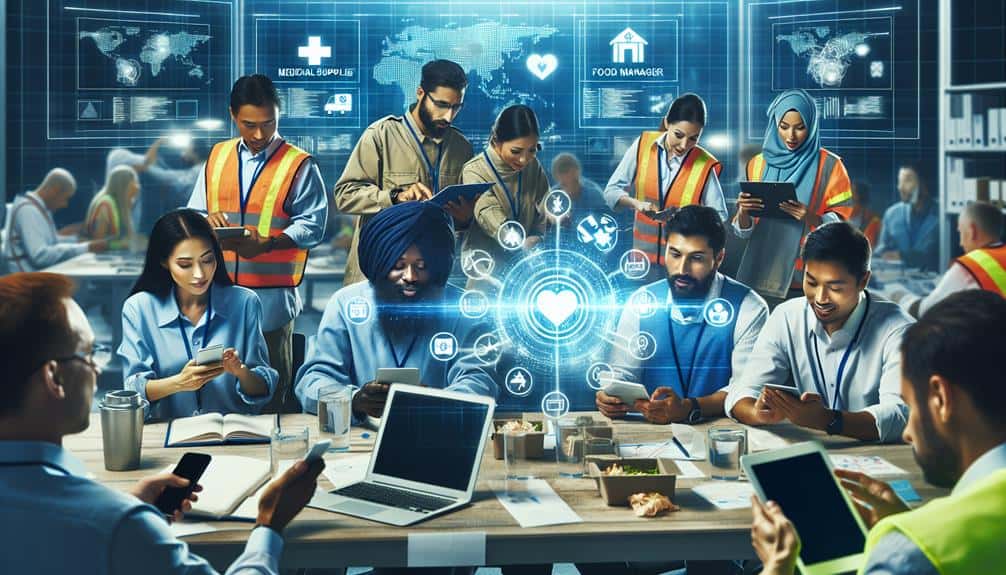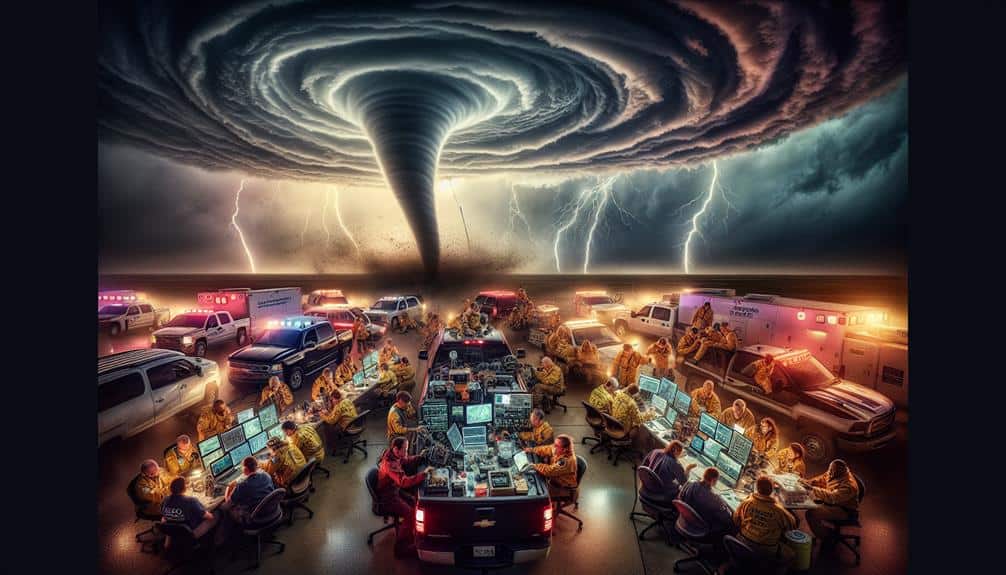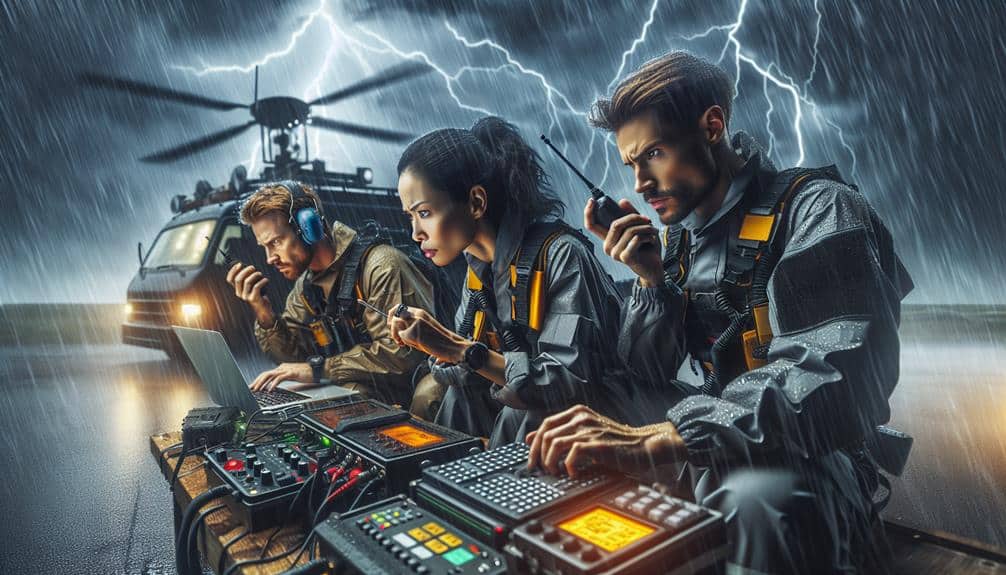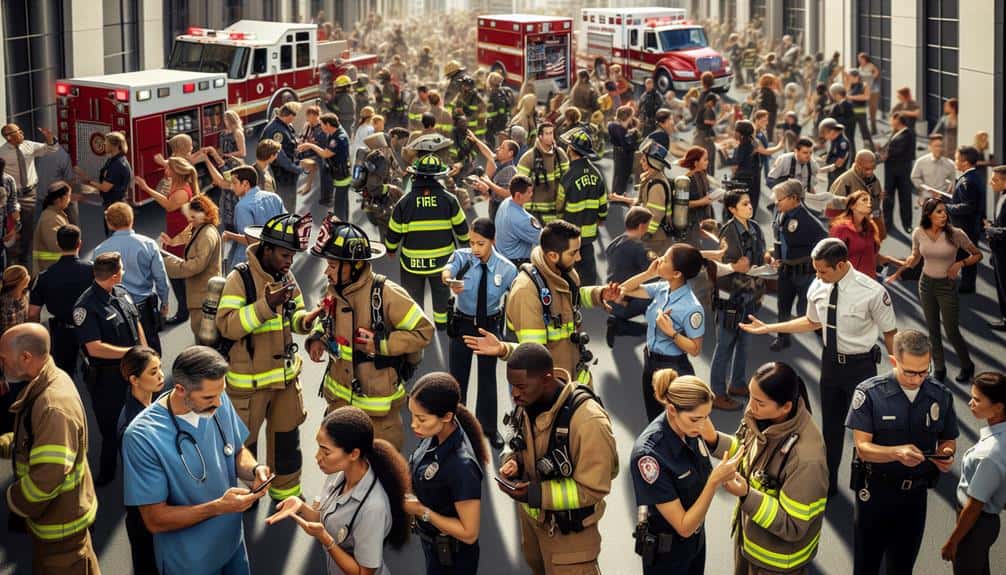We can utilize social media for emergency response by using real-time data to map disasters and track progress. Platforms like Twitter help us recruit volunteers and broadcast vital information instantly. With 75% of the public using social media to check on loved ones, community engagement and empowerment are essential. Our response times improve by 30% through high social media engagement, and real-time crisis mapping guarantees precise coordination. Additionally, data-driven resource allocation maximizes our impact. Want to explore further? There's more to discover about optimizing emergency responses through social media.
Key Points
- Social media facilitates real-time updates and information sharing to keep communities informed during emergencies.
- Crisis mapping and geospatial analysis tools on social media pinpoint affected areas for precise emergency response.
- Social media optimizes volunteer recruitment, coordination, and training, enhancing response efficiency.
- Data visualization tools transform raw social media data to track disaster spread and identify critical areas.
Real-Time Data Sharing
In today's fast-paced world, real-time data sharing on social media platforms enables emergency responders to quickly gather and disseminate crucial information. We're seeing a paradigm shift where rapid information dissemination can make the difference between life and death. Data visualization tools are a game-changer here, transforming raw data into understandable formats. These tools allow us to map affected areas, track the spread of disasters, and identify resource needs instantly.
By leveraging social media, we can tap into a vast well of user-generated content. This influx of real-time data helps us paint a clearer picture of ongoing situations. For instance, during natural disasters, social media platforms can provide live updates from affected individuals, allowing us to direct resources more efficiently.
Moreover, emergency responders can use these platforms to broadcast essential information, such as evacuation routes and safety instructions, to a broad audience in seconds. The immediacy of this communication can't be overstated. It gives everyone the freedom to make informed decisions quickly, enhancing overall response effectiveness.
In essence, real-time data sharing on social media, combined with powerful data visualization tools, revolutionizes how we approach emergency response, making it more agile and responsive.
Community Engagement
Community engagement on social media empowers us to build resilient networks that can act swiftly and cohesively during emergencies. By leveraging platforms like Twitter and Facebook, we can enhance community empowerment and disaster preparedness. Recent studies show that 75% of people use social media to check on loved ones during crises, highlighting its role in fostering social cohesion.
Engaging with our community online isn't just about sharing information; it's about building relationships and trust. According to a 2022 survey, communities with high social media engagement reported 30% faster response times during emergencies. This speed can save lives and minimize damage.
Our approach should be data-driven and audience-focused. For instance, analyzing social media trends can help us understand which messages resonate most and adjust our strategies accordingly. Sharing practical tips on disaster preparedness, like creating emergency kits or evacuation plans, can significantly boost community resilience.
Moreover, social media allows us to tap into the collective wisdom of the crowd. By encouraging community members to share their experiences and insights, we create a more informed and prepared network. This kind of engagement not only strengthens our immediate response capabilities but also builds long-term resilience.
Crisis Mapping
We're seeing social media transform crisis mapping through real-time data collection, allowing us to respond faster.
Crowdsourced information verification guarantees accuracy while geospatial analysis tools help us visualize and act on the data.
Collectively, these advancements enhance our ability to coordinate emergency responses efficiently.
Real-time Data Collection
Leveraging real-time data collection through crisis mapping, we can pinpoint disaster-affected areas instantly and allocate resources more effectively. By harnessing the power of social media, we're able to gather vast amounts of data as events unfold. This data, when visualized, provides a clear picture of the crisis landscape, helping us to make informed decisions quickly.
Data visualization tools transform raw social media inputs into actionable insights, highlighting hotspots that require immediate attention.
Emergency alerts disseminated via social media platforms make sure that we stay ahead of the curve, receiving and responding to critical information in real time. This rapid feedback loop allows us to mobilize resources, coordinate efforts, and deploy aid to the zones most in need.
In addition, real-time updates from affected populations provide an ongoing stream of situational awareness, enabling us to adapt our strategies dynamically.
Crowdsourced Information Verification
To guarantee the reliability of the data gathered during a crisis, we utilize crowdsourced information verification techniques to cross-check and validate reports from social media. This process relies on robust verification protocols, ensuring crowdsourcing accuracy. Our primary goal is to enhance information credibility by promoting online collaboration among a wide network of volunteers and experts.
We leverage platforms that allow users to submit data, which is then scrutinized through multiple layers of verification. Crowdsourced information is analyzed for consistency, cross-referenced with other reports, and checked against known data points. These methods help us filter out misinformation and highlight the most credible sources.
Our verification protocols are data-driven and continuously updated to keep pace with emerging trends. In a world where information spreads rapidly, the accuracy of crowdsourced data can make a significant difference in emergency response efforts. By harnessing the power of a connected, informed community, we increase the credibility of the information we disseminate.
Online collaboration is at the heart of our strategy. By engaging a diverse group of contributors, we ensure that our crisis mapping efforts are both thorough and precise, ultimately empowering everyone involved to make informed decisions during emergencies.
Geospatial Analysis Tools
Using advanced geospatial analysis tools, we create real-time crisis maps that provide critical insights for emergency response teams. These tools transform raw data into actionable disaster mapping, enabling us to visualize the extent and impact of crises as they unfold.
By integrating social media feeds, GPS data, and satellite imagery, we offer a comprehensive view of affected areas, helping responders allocate resources more efficiently.
In emergency communication, timing is everything. Our geospatial analysis tools ensure that real-time information reaches the right people at the right moment. For instance, during natural disasters like hurricanes or earthquakes, our crisis maps can highlight evacuation routes, shelter locations, and areas in dire need of assistance.
This data-driven approach empowers communities, granting them the freedom to make informed decisions quickly.
Recent trends show a rising demand for agile and precise disaster response. Leveraging these cutting-edge tools, we stay ahead of the curve, adapting to the ever-changing landscape of emergency management.
Volunteer Coordination
Effective volunteer coordination on social media depends on real-time communication, streamlined information sharing, and leveraging user engagement analytics. By integrating these elements, we can optimize volunteer recruitment and training, making our emergency response efforts more agile and effective.
To start, social media platforms allow us to reach a broad audience quickly, enhancing our volunteer recruitment efforts. By analyzing engagement metrics, we can pinpoint the most effective messages and channels, ensuring we're targeting individuals who are ready to help. Training modules can be disseminated via these platforms, allowing volunteers to get up to speed swiftly and efficiently.
Organizational partnerships play a pivotal role in this process. Through strong communication channels, we can coordinate with partner organizations to share resources and expertise, ensuring that our volunteer force is well-prepared and responsive.
Key strategies include:
- Real-time updates: Keeping volunteers informed instantly boosts responsiveness.
- Interactive content: Engaging posts, videos, and live sessions enhance understanding and retention.
Resource Allocation

Amid evolving emergency scenarios, our priority in resource allocation hinges on real-time data analysis and strategic distribution to ensure maximum efficiency and impact. By leveraging social media, we can gather immediate insights into the areas most affected and the specific resources needed. This data-driven approach guarantees our response teams are dispatched to the right locations with the right supplies, minimizing delays and maximizing effectiveness.
Resource distribution isn't just about physical supplies; it's also about optimizing human resources. Through platforms like Twitter and Facebook, we can coordinate with mutual aid networks to mobilize local volunteers and professionals swiftly. This real-time coordination allows us to fill gaps in our emergency planning, ensuring no community is left underserved.
Moreover, social media analytics provide us with trends and patterns that help refine our emergency planning. By understanding how resources were allocated in past events and the resultant outcomes, we can continuously improve our strategies. The goal is to create a seamless, flexible, and responsive framework that adapts to each unique crisis.
In essence, our approach to resource allocation through social media empowers us to act swiftly and decisively, embodying the freedom and adaptability our audience values.
Public Awareness
We can boost public awareness by leveraging social media for real-time information sharing, which 72% of people now expect during emergencies.
By engaging community networks, we can amplify critical updates and guarantee timely dissemination.
This approach not only keeps everyone informed but also fosters a more resilient and connected community.
Real-Time Information Sharing
How can real-time information sharing through social media elevate public awareness during emergencies? By harnessing the power of platforms like Twitter, Facebook, and Instagram, we can revolutionize crisis communication and guarantee a rapid response. Immediate and accurate information dissemination is essential in keeping communities informed and safe.
When we think about the value of real-time updates, several key benefits stand out:
- Speed: Information is shared instantly, allowing people to react quickly.
- Reach: Social media platforms connect us to a vast audience, ensuring that vital updates reach as many people as possible.
Data shows that during emergencies, timely updates can reduce panic and help coordinate relief efforts more effectively. According to a Pew Research study, 62% of adults get news on social media, highlighting the importance of these platforms in our crisis communication strategies.
Engaging Community Networks
Harnessing the power of real-time updates, we can amplify public awareness by actively engaging community networks on social media platforms. By tapping into community empowerment, we create a robust digital outreach strategy that ensures essential information reaches those who need it most.
When every second counts, social media's immediacy allows us to disseminate updates swiftly and efficiently, bridging the gap between emergency services and the public.
We can drive grassroots mobilization by encouraging local influencers and community leaders to share critical information. Their established trust within their communities can significantly enhance the reach and credibility of our messages. Data shows that posts shared by trusted figures are more likely to be acted upon, making this approach both practical and effective.
Online activism plays a pivotal role in this strategy. By utilizing hashtags and coordinated campaigns, we can galvanize community networks to participate actively in emergency response efforts. This collective action not only spreads awareness but also fosters a sense of unity and shared responsibility.
As we continue to innovate our digital outreach, we empower communities to become proactive participants in their own safety and well-being, embracing the freedom to act swiftly and decisively in times of crisis.
Frequently Asked Questions
How Can Social Media Analytics Predict Potential Emergencies?
We can predict potential emergencies by using predictive modeling and real-time monitoring of social media analytics. This approach empowers us with timely data, enabling proactive measures and ensuring the freedom to respond swiftly and effectively.
What Are the Privacy Concerns With Using Social Media for Emergency Response?
When we use social media for emergency response, we must address privacy concerns. Data protection and ethical considerations are crucial to guarantee that individuals' freedom isn't compromised while leveraging this powerful tool for public safety.
How Do You Verify the Credibility of Social Media Information During Emergencies?
We verify the credibility of social media information during emergencies through robust information validation practices. Effective crisis communication involves rigorous rumor control and consistent trust building, ensuring accurate and reliable updates reach our audience quickly.
What Role Does Artificial Intelligence Play in Analyzing Social Media Data for Emergencies?
In the heat of chaos, AI algorithms shine by providing real-time analysis of social media data. They sift through the noise, identifying critical information swiftly, giving us the freedom to respond effectively and save lives.
How Can Social Media Be Used to Support Mental Health During Crises?
We can use social media to provide crisis intervention and online support, boosting community resilience. By amplifying outreach efforts, we connect individuals with mental health resources quickly, fostering a supportive, informed community during crises.


